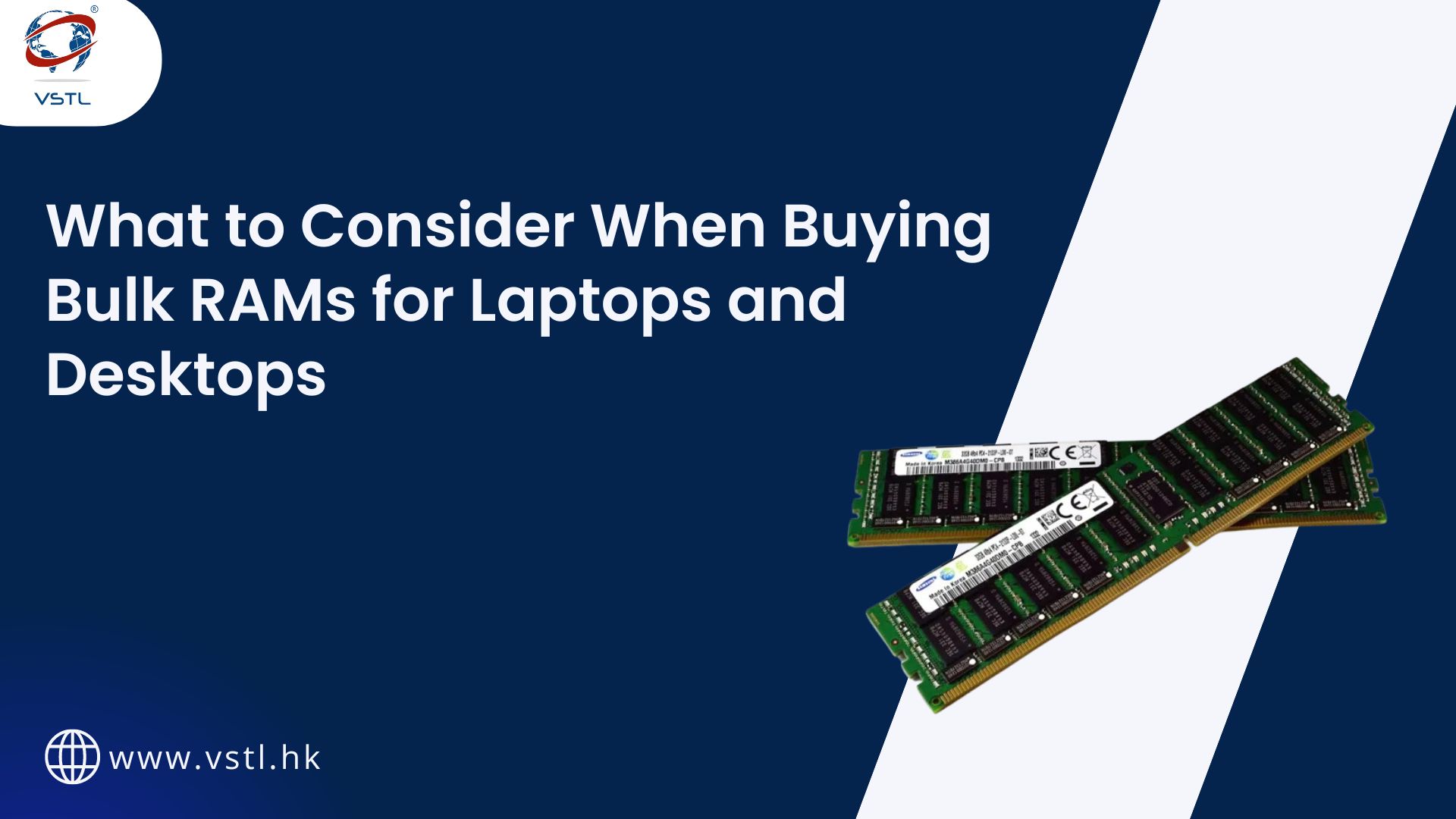
When you’re buying RAM (Random Access Memory) in bulk for laptops and desktops, whether for your business or personal use, it’s essential to make sure you’re getting the right kind of memory. RAM is crucial for a computer’s performance, and buying the wrong type or poor-quality RAM can lead to frustrating issues, wasted money, and underperforming devices.
This guide will take you through everything you need to consider when purchasing bulk RAM, breaking down the technical aspects into simple, easy-to-understand language.
1. Understand the Basics of RAM
Before diving into what you should look for when buying RAM in bulk, it’s important to understand the basics.
- What is RAM?
RAM is the memory in your computer that stores data temporarily while the system is running. It’s different from your hard drive or SSD, which stores data permanently. RAM is fast and allows your computer to access the data it needs quickly. - Why is RAM Important?
The more RAM your computer has, the more data it can handle at once. This means smoother multitasking, faster load times, and better performance in tasks like gaming, video editing, and running applications.
2. Determine the Type of RAM You Need
There are different types of RAM available, and it’s crucial to get the right type for your laptops and desktops.
- DDR Versions (DDR3, DDR4, DDR5):
DDR stands for Double Data Rate, and it’s the standard type of RAM used in most computers. The version numbers (DDR3, DDR4, DDR5) refer to different generations of this technology. Each newer generation offers better speed and efficiency. However, they are not interchangeable. If your device uses DDR4 RAM, you cannot use DDR3 or DDR5. Check the specifications of the laptops or desktops you are buying RAM for to ensure compatibility. - Form Factors (DIMM vs. SO-DIMM):
DIMMs (Dual Inline Memory Modules) are typically used in desktops, while SO-DIMMs (Small Outline DIMMs) are used in laptops. Make sure you know which form factor your computers need. The physical size and layout are different, so they won’t fit if you choose the wrong one.
3. Consider the Capacity
The capacity of RAM is measured in gigabytes (GB), and the amount you need depends on how the computers will be used.
- 4GB to 8GB:
This is generally sufficient for basic tasks like browsing the web, using office applications, and watching videos. - 8GB to 16GB:
This is better for more intensive tasks like gaming, graphic design, or heavy multitasking. - 16GB and Above:
This is typically used for professional applications, like video editing, 3D rendering, and other resource-heavy software.
When buying in bulk, consider the typical use case of the devices you’re upgrading. If they’re going to be used for basic office tasks, 8GB might be plenty. If they’re for gaming or professional workstations, aim for higher capacities.
4. Check Compatibility
Not all RAM is compatible with all systems. Here’s what you need to check:
- Motherboard Compatibility:
The motherboard is the main circuit board in a computer. It needs to support the type and speed of RAM you’re buying. Check the motherboard specifications to see the maximum RAM capacity it supports, the number of RAM slots, and the type of RAM (DDR3, DDR4, etc.). - Processor Compatibility:
The CPU (Central Processing Unit) also needs to support the RAM. Most modern CPUs support a range of RAM types and speeds, but it’s still important to verify this before purchasing.
5. Speed Matters
RAM speed is measured in megahertz (MHz), and higher speeds can lead to better performance.
- Speed Ratings:
You might see RAM advertised as DDR4-2400, DDR4-3200, etc. The number after DDR refers to the speed. Higher numbers mean faster RAM. However, the motherboard and CPU need to support these speeds, or the RAM will run at a lower speed. - Latency:
Latency is another factor in RAM performance. It’s often measured in CL (CAS Latency) numbers, like CL16, CL18, etc. Lower latency numbers mean faster performance, but the difference is usually small compared to the impact of speed and capacity.
6. Quality and Brand Reliability
When buying RAM in bulk, it’s essential to choose reliable brands and quality products.
- Trusted Brands:
Stick to well-known brands like Corsair, Kingston, Crucial, and G.Skill. These companies have a reputation for quality and reliability. - Warranty:
A good warranty is a sign of confidence in the product’s quality. Most reputable brands offer a lifetime warranty on their RAM, which is important when you’re buying in bulk and need assurance that the product will last. - Quality Testing:
Some RAM is labeled as “tested” or “certified” for specific motherboards or systems. This means the manufacturer has tested the RAM to ensure compatibility and performance, reducing the risk of issues.
7. Bulk Pricing and Deals
Buying in bulk usually means you’ll get a discount, but it’s important to shop around to get the best price.
- Wholesale Suppliers:
Consider buying directly from wholesale suppliers or manufacturers to get the best prices. These suppliers often offer significant discounts when you purchase large quantities. - Check for Volume Discounts:
Some retailers and online stores offer volume discounts. The more you buy, the lower the price per unit. Be sure to compare different sellers to find the best deal. - Beware of Too-Good-To-Be-True Deals:
If a deal seems too good to be true, it probably is. Extremely low prices might indicate counterfeit or low-quality products. Stick to reputable sellers to avoid this risk.
8. Consider Future-Proofing
Technology evolves quickly, and you don’t want to end up with outdated hardware shortly after your purchase.
- Buy the Latest Generation:
Whenever possible, buy the latest generation of RAM (e.g., DDR5 instead of DDR4). Even if your current systems only support DDR4, future systems may require DDR5, and having compatible RAM on hand could save you money in the long run. - Consider Upgradability:
If you’re upgrading existing systems, consider how much additional RAM they might need in the future. If a system currently has 8GB and can support up to 32GB, you might consider buying 16GB sticks so you can easily upgrade later.
9. Check for Return Policies and Support
Even when you’re careful, mistakes can happen. A good return policy is essential, especially when buying in bulk.
- Return Policy:
Ensure the seller has a clear return policy in case the RAM isn’t compatible or you encounter issues. Check how long you have to return items and whether there are any restocking fees. - Technical Support:
Choose a supplier that offers good technical support. If you run into compatibility issues or need help with installation, responsive customer service can save you a lot of headaches.
10. Environmental and Ethical Considerations
As a responsible buyer, it’s also worth considering the environmental and ethical aspects of your purchase.
- Energy Efficiency:
Look for RAM that’s energy-efficient. This not only helps reduce the overall power consumption of your computers but can also save on electricity costs in the long run. - Sustainability:
Some manufacturers are more committed to sustainability than others. Look for companies that use eco-friendly materials and packaging, and those that have a commitment to reducing their carbon footprint. - Ethical Sourcing:
Consider whether the RAM you’re buying is made by companies that adhere to ethical labor practices. Supporting businesses that treat their workers fairly is an important aspect of responsible purchasing.
11. Plan for Installation and Deployment
Once you’ve purchased your bulk RAM, you’ll need to install it in your systems. Proper planning can make this process smooth and efficient.
- Installation Process:
Installing RAM is generally straightforward, but it’s important to handle the modules carefully to avoid damaging them. Make sure you have the necessary tools and follow the installation instructions provided by the manufacturer. - Testing:
After installation, it’s crucial to test the RAM to ensure it’s functioning correctly. There are software tools available that can help you test the memory for errors. Running these tests on each machine will help catch any faulty modules early. - Documentation:
Keep good records of the RAM you’ve installed in each machine. This can be helpful for future upgrades or troubleshooting. Make a note of the RAM capacity, speed, and any specific configurations you’ve used.
12. Consider Long-Term Storage and Handling
If you’re not using all the RAM immediately, you’ll need to store it properly.
- Storage Conditions:
Store RAM in a cool, dry place. Avoid exposure to static electricity, as this can damage the memory modules. Many RAM sticks come in anti-static packaging, which should be used for storage. - Inventory Management:
Keep track of your inventory, especially if you’re storing RAM for future use. Use an inventory management system to track how much RAM you have, where it’s stored, and when it needs to be used.
Conclusion
Buying bulk RAM for laptops and desktops is an investment that can significantly improve the performance of your systems. By understanding the basics, choosing the right type and capacity, ensuring compatibility, and paying attention to quality and pricing, you can make a smart purchase that meets your needs. Remember to consider future-proofing, return policies, and the environmental impact of your purchase. With proper planning and installation, your bulk RAM purchase will help keep your systems running smoothly for years to come.

